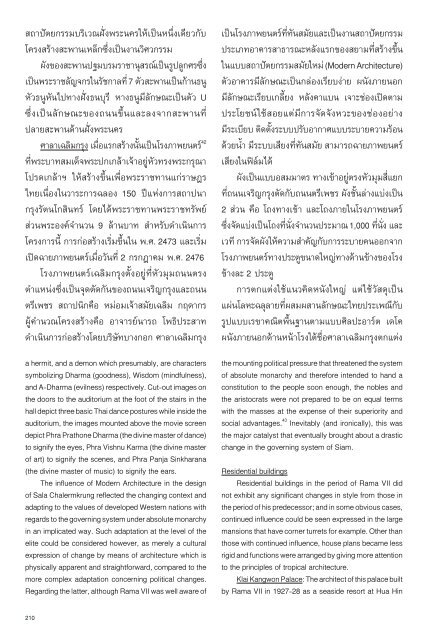บ้านเรือนถิ่นไทยในช่วงเจ็ดทศวรรษ 2489-2559
Create successful ePaper yourself
Turn your PDF publications into a flip-book with our unique Google optimized e-Paper software.
สถาปัตยกรรมบริเวณฝั่งพระนครให้เป็นหนึ่งเดียวกับ<br />
โครงสร้างสะพานเหล็กซึ่งเป็นงานวิศวกรรม<br />
ผังของสะพานปฐมบรมราชานุสรณ์เป็นรูปลูกศรซึ่ง<br />
เป็นพระราชลัญจกรในรัชกาลที่ 7 ตัวสะพานเป็นก้านธนู<br />
หัวธนูหันไปทางฝั่งธนบุรี หางธนูมีลักษณะเป็นตัว U<br />
ซึ่งเป็นลักษณะของถนนขึ้นและลงจากสะพานที่<br />
ปลายสะพานด้านฝั่งพระนคร<br />
ศาลาเฉลิมกรุง เมื่อแรกสร้างนั้นเป็นโรงภาพยนตร์42<br />
ที่พระบาทสมเด็จพระปกเกล้าเจ้าอยู่หัวทรงพระกรุณา<br />
โปรดเกล้าฯ ให้สร้างขึ้นเพื่อพระราชทานแก่ราษฎร<br />
ไทยเนื ่องในวาระการฉลอง 150 ปีแห่งการสถาปนา<br />
กรุงรัตนโกสินทร์ โดยได้พระราชทานพระราชทรัพย์<br />
ส่วนพระองค์จำนวน 9 ล้านบาท สำหรับดำเนินการ<br />
โครงการนี้ การก่อสร้างเริ่มขึ้นใน พ.ศ. 2473 และเริ่ม<br />
เปิดฉายภาพยนตร์เมื่อวันที่ 2 กรกฎาคม พ.ศ. 2476<br />
โรงภาพยนตร์เฉลิมกรุงตั้งอยู่ที่หัวมุมถนนตรง<br />
ตำแหน่งซึ่งเป็นจุดตัดกันของถนนเจริญกรุงและถนน<br />
ตรีเพชร สถาปนิกคือ หม่อมเจ้าสมัยเฉลิม กฤดากร<br />
ผู้คำนวณโครงสร้างคือ อาจารย์นารถ โพธิประสาท<br />
ดำเนินการก่อสร้างโดยบริษัทบางกอก ศาลาเฉลิมกรุง<br />
a hermit, and a demon which presumably, are characters<br />
symbolizing Dharma (goodness), Wisdom (mindfulness),<br />
and A-Dharma (evilness) respectively. Cut-out images on<br />
the doors to the auditorium at the foot of the stairs in the<br />
hall depict three basic Thai dance postures while inside the<br />
auditorium, the images mounted above the movie screen<br />
depict Phra Prathone Dharma (the divine master of dance)<br />
to signify the eyes, Phra Vishnu Karma (the divine master<br />
of art) to signify the scenes, and Phra Panja Sinkharana<br />
(the divine master of music) to signify the ears.<br />
The influence of Modern Architecture in the design<br />
of Sala Chalermkrung reflected the changing context and<br />
adapting to the values of developed Western nations with<br />
regards to the governing system under absolute monarchy<br />
in an implicated way. Such adaptation at the level of the<br />
elite could be considered however, as merely a cultural<br />
expression of change by means of architecture which is<br />
physically apparent and straightforward, compared to the<br />
more complex adaptation concerning political changes.<br />
Regarding the latter, although Rama VII was well aware of<br />
เป็นโรงภาพยนตร์ที่ทันสมัยและเป็นงานสถาปัตยกรรม<br />
ประเภทอาคารสาธารณะหลังแรกของสยามที่สร้างขึ้น<br />
ในแบบสถาปัตยกรรมสมัยใหม่ (Modern Architecture)<br />
ตัวอาคารมีลักษณะเป็นกล่องเรียบง่าย ผนังภายนอก<br />
มีลักษณะเรียบเกลี้ยง หลังคาแบน เจาะช่องเปิดตาม<br />
ประโยชน์ใช้สอยแต่มีการจัดจังหวะของช่องอย่าง<br />
มีระเบียบ ติดตั้งระบบปรับอากาศแบบระบายความร้อน<br />
ด้วยน้ำ มีระบบเสียงที่ทันสมัย สามารถฉายภาพยนตร์<br />
เสียงในฟิล์มได้<br />
ผังเป็นแบบอสมมาตร ทางเข้าอยู่ตรงหัวมุมสี่แยก<br />
ที่ถนนเจริญกรุงตัดกับถนนตรีเพชร ผังชั้นล่างแบ่งเป็น<br />
2 ส่วน คือ โถงทางเข้า และโถงภายในโรงภาพยนตร์<br />
ซึ่งจัดแบ่งเป็นโถงที่นั่งจำนวนประมาณ 1,000 ที่นั่ง และ<br />
เวที การจัดผังให้ความสำคัญกับการระบายคนออกจาก<br />
โรงภาพยนตร์ทางประตูขนาดใหญ่ทางด้านข้างของโรง<br />
ข้างละ 2 ประตู<br />
การตกแต่งใช้แนวคิดหนังใหญ่ แต่ใช้วัสดุเป็น<br />
แผ่นโลหะฉลุลายที่ผสมผสานลักษณะไทยประเพณีกับ<br />
รูปแบบเรขาคณิตพื้นฐานตามแบบศิลปะอาร์ต เดโค<br />
ผนังภายนอกด้านหน้าโรงใต้ชื่อศาลาเฉลิมกรุงตกแต่ง<br />
the mounting political pressure that threatened the system<br />
of absolute monarchy and therefore intended to hand a<br />
constitution to the people soon enough, the nobles and<br />
the aristocrats were not prepared to be on equal terms<br />
with the masses at the expense of their superiority and<br />
social advantages. 43 Inevitably (and ironically), this was<br />
the major catalyst that eventually brought about a drastic<br />
change in the governing system of Siam.<br />
Residential buildings<br />
Residential buildings in the period of Rama VII did<br />
not exhibit any significant changes in style from those in<br />
the period of his predecessor; and in some obvious cases,<br />
continued influence could be seen expressed in the large<br />
mansions that have corner turrets for example. Other than<br />
those with continued influence, house plans became less<br />
rigid and functions were arranged by giving more attention<br />
to the principles of tropical architecture.<br />
Klai Kangwon Palace: The architect of this palace built<br />
by Rama VII in 1927-28 as a seaside resort at Hua Hin<br />
210


















